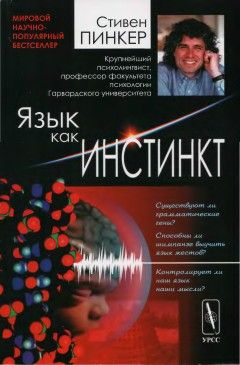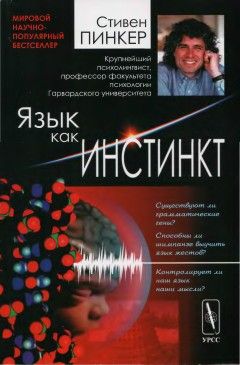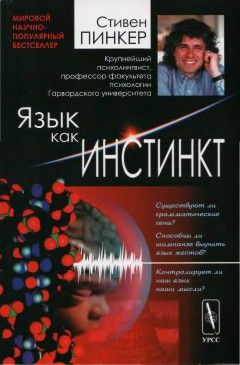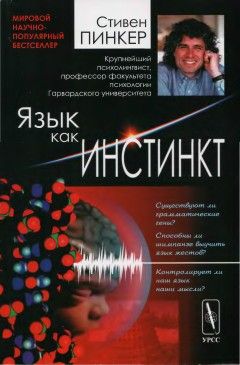Kuno S. 1974. The position of relative clauses and conjunctions // Linguistic Inquiry, 5. P. 117–136.
Labov W. 1969. The logic ofnonstandard English // Georgetown Monographs on Language and Linguistics, 22. P. 1–31.
Ladefoged P. 1992. Another view of endangered languages // Language, 68, 809–811.
Lakoff G. 1987. Women, fire, and dangerous things. Chicago: University of Chicago Press.
Lakoff G. & Johnson M. 1980. Metaphors we live by. Chicago: University of Chicago Press (рус. пер.: Лакофф Дж., Джонсон М. Метафоры, которыми мы живем. М.: УРСС, 2004).
Lakoff R. 1990. Talking power: The politics of language in our lives. New York: Basic Books.
Lambert D. & The Diagram Group. 1987. The field guide to early man. New York: Facts on File Publications.
Lederer R. 1987. Anguished English. Charleston: Wyrick.
Lederer R. 1990. Crazy English. New York: Pocket Books.
Leech G. N. 1983. Principles of pragmatics. London: Longman.
Lenat D. B. & Guha D. V. 1990. Building large knowledge-based systems // Reading, Mass.: Addison-Wesley.
Lenneberg E. H. 1953. Cognition and ethnolinguistics // Language, 29, 463–471.
Lenneberg E. H. 1967. Biological foundations of language. New York: Wiley.
Lesser V. R., Fennel R. D., Erman L. D. & Reddy R. D. 1975. The Hearsay II speech understanding system // IEEE Transactions on Acoustics, Speech, and Signal Processing, 23. P. 11–24.
Levinson S. C. 1983. Pragmatics. New York: Cambridge University Press.
Lewin R. 1980. Is your brain really necessary? // Science, 210. P. 1232–1234.
Lewontin R. C. 1966. Review of G. C. Williams’ «Adaptation and natural selection» // Science, 152. P. 338–339.
Lewontin R. C. 1982. Human diversity. San Francisco: Scientific American.
Lewontin R. C., Rose S. & Kamin L. 1984. Not in our genes. New York: Pantheon.
Liberman A. M., Cooper F. S., Shankweiler D. P. & Studdert-Kennedy M. 1967. Perception of the speech code // Psychological Review, 74. P. 431–461.
Liberman A. M. & Mattingly I. G. 1989. A specialization for speech perception // Science, 243. P. 489–494.
Lieberman P. 1984. The biology and evolution of language. Cambridge, Mass.: Harvard University Press.
Lieberman P. 1990. Not invented here // Pinker & Bloom. 1990.
Lieberman P., Kako. E., Friedman J., Tajchman G., Feldman L. S. & Jiminez E. B. 1992. Speech production, syntax comprehension, and cognitive deficits in Parkinson’s Disease // Brain and Language, 43. P. 169–189.
Limber J. 1973. The genesis of complex sentences // T. E. Moore (Ed.), Cognitive development and the acquisition of language. New York: Academic Press.
Linebarger M., Schwartz M. F. & Saffran E. M. 1983. Sensitivity to grammatical structure in so-called agrammatic aphasics // Cognition, 13. P. 361–392.
Liu L. G. 1985. Reasoning counterfactually in Chinese: Are there any obstacles? // Cognition, 21. P. 239–270.
Locke J. L. 1992. Structure and stimulation in the ontogeny of spoken language // Developmental Psychobiology, 28. P. 430–440.
Locke J. L. & Mather P. L. 1989. Genetic factors in the ontogeny of spoken language: Evidence from monozygotic and dizygotic twins // Journal of Child Language, 16. P. 553–559.
Logan R. K. 1986. The alphabet effect. New York: St. Martin’s Press.
Long M. H. 1990. Maturational constraints on language development // Studies in Second Language Acquisition, 12. P. 251–285.
Lorge I. & Chall J. 1963. Estimating the size of vocabularies of children and adults: An analysis of methodological issues. Journal of Experimental Education, 32. P. 147–157.
Ludlow C. L. & Cooper J. A. (Eds.) 1983. Genetic aspects of speech and language disorders. New York: Academic Press.
Lykken D. T., McGue M., Tellegen A. & Bouchard T. J., Jr. 1992. Emergenesis: Genetic traits that may not run in families // American Psychologist, 47. P. 1565–1577.
MacDonald M. C. 1989. Priming effects from gaps to antecedents // Language and Cognitive Processes, 4. P. 1–72.
MacDonald M. C., Just M. A. & Carpenter P. A. 1992. Working memory constraints on the processing of syntactic ambiguity // Cognitive Psychology, 24. P. 56–98.
MacWhinney, B. 1991. The CHILDES Project: Tools for Analyzing Talk. Hillsdale, N. J.: Erlbaum.
Malotki E. 1983. Hopt lime: A linguistic analysis of temporal concepts in the Hopi language. Berlin: Mouton.
Marcus G. F. 1993. Negative evidence in language acquisition // Cognition, 46. P. 53–85.
Marcus G. F., Brinkmann U., Clahsen H., Wiese R., Woest A. & Pinker S. 1993. German inflection: The exception that proves the rule. MIT Center for Cognitive Science Occasional Paper #47.
Marcus G. F., Pinker S., Ullman M., Hollander M., Rosen T. J. & Xu F. 1992. Overregularization in language acquisition // Monographs of the Society for Research in Child Development, 57.
Markman E. 1989. Categorization and naming in children: Problems of induction. Cambridge, Mass.: MIT Press.
Marr D. 1982. Vision. San Francisco: Freeman.
Marslen-Wilson W. 1975. Sentence comprehension as an interactive, parallel process. Science, 189. P. 226–228.
Marslen-Wilson W. (Ed.) 1989. Lexical representation and process. Cambridge, Mass.: MIT Press.
Martin L. 1986. «Eskimo words for snow»: A case study in the genesis and decay of an anthropological example // American Anthropologist, 88. P. 418–423.
Martin P. & Klein R. 1984. Quaternary extinctions. Tucson: University of Arizona Press.
Mather P. & Black K. 1984. Hereditary and environmental influences on preschool twins’ language skills. Developmental Psychology, 20. P. 303–308.
Mattingly I. G. & Studdert-Kennedy M. (Eds.) 1991. Modularity and the motor theory of speech perception. Hillsdale, N. J.: Erlbaum.
Maynard Smith J. 1984. Optimization theory in evolution // E. Sober (Ed.), Conceptual issues in evolutionary biology. Cambridge, Mass.: MIT Press.
Maynard Smith J. 1986. The problems of biology. Oxford: Oxford University Press.
Maynard Smith J. 1988. Games, sex, and evolution. New York: Harvester Wheatsheaf.
Mayr E. 1982. The growth of biological thought. Cambridge, Mass.: Harvard University Press.
Mayr E. 1983. How to carry out the adaptationist program // American Naturalist, 121. P. 324–334.
Mazoyer B. M., Dehaene S., Tzourio N., Murayama N., Cohen L., Levrier O., Salamon G., Syrota A. & Mehler J. 1992. The cortical representation of speech. Unpublished manuscript, Laboratoire de Sciences Cognitives et Psycholinguistique, Centre Nationale de la Recherche Scientifique, Paris.
McClelland J. L., Rumelhart D. E. & The PDP Research Group. 1986. Parallel distributed processing: Explorations in the microstructure of cognition, Vol. 2: Psychological and biological models. Cambridge, Mass.: MIT Press.
McCrum R., Cran W. & MacNeil R. 1986. The story of English. New York: Viking.
McCulloch W. S. & Pitts W. 1943. A logical calculus of the ideas immanent in nervous activity // Bulletin of Mathematical Biophysics, 5. P. 115–133.
McDermott D. 1981. Artificial intelligence meets natural stupidity // Haugeland, 1981.
McGurk H. & MacDonald J. 1976. Hearing lips and seeing voices. Nature, 264. P. 746–748.
Mead M. 1935. Sex and temperament in three primitive societies. New York: Morrow.
Medawar P. B. 1957. An unsolved problem in biology // P. B. Medawar. The uniqueness of the individual. London: Methuen.
Mehler J., Jusczyk P. W., Lambertz G., Halsted N., Bertoncini J. & Amiel-Tison C. 1988. A precursor to language acquisition in young infants // Cognition, 29. P. 143–178.
Mencken H. 1936. The American language. New York: Knopf.
Miceli G. & Caramazza A. 1988. Dissociation of inflectional and derivational morphology // Brain and Language, 35. P. 24–65.
Miceli G., Silveri M. C., Romani C. & Caramazza A. 1989. Variation in the pattern of omissions and substitutions of grammatical morphemes in the spontaneous speech of so-called agrammatic patients // Brain and Language, 36. P. 447–492.
Miller G. A. 1956. The magical number seven, plus or minus two: Some limits on our capacity for processing information // Psychological Review, 63. P. 81–96.
Miller G. A. 1967. The psychology of communication. London: Penguin Books.
Miller G. A. 1977. Spontaneous apprentices: Children and language. New York: Seabury Press.
Miller G. A. 1991. The science of words. New York: Freeman.
Miller G. A. & Chomsky N. 1963. Finitary models of language users // R. D. Luce, R. Bush, and E. Galanter (Eds.), Handbook of mathematical psychology, Vol. 2. New York: Wiley.
Miller G. A. & Selfridge J. 1950. Verbal context and the recall of meaningful material // American Journal of Psychology, 63. P. 176–185.
Miyamoto M. M., Slightom J. L. & Goodman M. 1987. Phylogenetic relations of humans and African apes from DNA sequences in the ψη-globin region // Science, 238. P. 369–373.
Modgil S. & Modgil C. (Eds.) 1987. Noam Chomsky: Consensus and controversy. New York: Falmer Press.
Morgan J. L. & Travis L. L. 1989. Limits on negative information in language learning // Journal of Child Language, 16. P. 531–552.
Munsinger H. & Douglass A. 1976. The syntactic abilities of identical twins, fraternal twins and their siblings // Child Development, 47. P. 40–50.
Murdock G. P. 1975. Outline of world’s cultures (5th ed.). New Haven, Conn.: Human Relations Area Files.
Murphy K. 1992. «To be» in their bonnets // Atlantic Monthly, February.
Myers R. E. 1976. Comparative neurology of vocalization and speech: Proof of a dichotomy // Harnad, Steklis, & Lancaster 1976.
Nabokov V. 1958. Lolita. New York: Putnam. (Рус. пер. автора: Набоков В. Лолита. М., 1989.)
Neisser A. 1983. The other side of silence. New York: Knopf.
Neville H., Nicol J. L., Barss A., Forster K. I. & Garrett M. F. 1991. Syntactically based sentence processing classes: Evidence from eventrelated brain potentials // Journal of Cognitive Neuroscience, 3, 151–165.
New York Times Staff. 1974. The White House Transcripts. New York: Bantam Books.
Newmeyer F. 1991. Functional explanation in linguistics and the origin of language // Language and Communication, 11. P. 3–96.
Newport E. 1990. Maturational constraints on language learning // Cognitive Science, 14. P. 11–28.
Newport E., Gleitman H. & Gleitman E. 1977. Mother I’d rather do it myself: Some effects and non-effects of maternal speech style // C. E. Snow and C. A. Ferguson (Eds.), Talking to children: Language input and acquisition. Cambridge: Cambridge University Press.
Nicol J. & Swinney D. A. 1989. Coreference processing during sentence comprehension // Journal of Psycholinguistic Research, 18. P. 5–19.
Norman D. & Rumelhart D. E. (Eds.) 1975. Explorations in cognition. San Francisco: Freeman.
Nunberg G. 1992. Usage in The American Heritage Dictionary: The place of criticism // The American Heritage Dictionary of the English language (3rd ed.). Boston: Houghton Mifflin.
Ojemann G. A. 1991. Cortical organization of language // Journal of Neuroscience, 11. P. 2281–2287.
Ojemann G. A. & Whitaker H. A. 1978. Language localization and variability. Brain and Language, 6. P. 239–260.
Orians G. H. & Heerwagen J. H. 1992. Evolved responses to andscapes // Barkow, Cosmides, & Tooby. 1992.
Osherson D. N., Stob M., and Weinstein S. 1985. Systems that learn. Cambridge, Mass.: MIT Press.
Osherson D. N. & Lasnik H. (Eds.) 1990 // Language: An invitation to cognitive science, Vol. 1. Cambridge, Mass.: MIT Press.
Osherson D. N, Kosslyn S. M. & Hollerbach J. M. (Eds.) 1990. Visual cognition and action: An invitation to cognitive science, Vol. 2. Cambridge, Mass.: MIT Press.
Osherson D. N. & Smith, E. E. (Eds.) 1990. Thinking: An invitation to cognitive science, Vol. 3. Cambridge, Mass.: MIT Press.
Patterson F. G. 1978. The gestures of a gorilla: Language acquisition in another pongid // Brain and Language, 5. P. 56–71.
Peters A. M. 1983. The units of language acquisition. New York: Cambridge University Press.
Peterson S. E., Fox P. T., Posner M. I., Mintun M. & Raichle M. E. 1988. Positron emission tomographic studies of the cortical anatomy of single-word processing. Nature, 331. P. 585–589.
Peterson S. E., Fox P. T., Snyder A. Z. & Raichle M. E. 1990. Activation of extrastriate and frontal cortical areas by visual words and word-like stimuli // Science, 249. P. 1041–1044.
Petitto L. A. 1988, «Language» in the prelinguistic child // F. Kessel (Ed.), The development of language and of language researchers: Papers presented to Roger Brown. Hillsdale, N. J.: Erlbaum.





